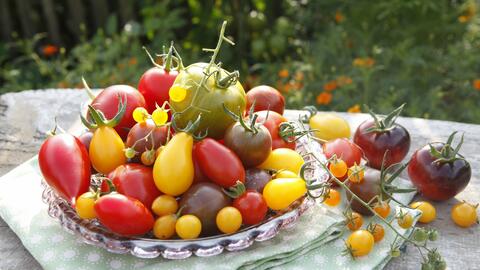The Best Tips for Tasty Tomatoes
Plant in early May and you’ll be able to pluck the first tomatoes just eight weeks later. Whether big or small, red, yellow, or green-striped – growing your own guarantees maximum enjoyment. We reveal the best tips for tasty tomatoes.

The number of varieties on offer increases year after year. Flavors range from sweet and refreshingly fruity to mild or slightly sour
Anyone who wants tomatoes with an intense flavor can grow them in their own garden. But which tomatoes actually taste best? The annual top ten tomato tasting lists go some way to answering this question. The flavor is largely shaped by the soil, water and nutrient supply, as well as other location factors. And last but not least, there’s the individual taste of the tomatoes. Sweet, mild, fruity or refreshingly sour? There’s only one thing to do if you want to find your own personal favorites: keep trying different varieties!
There is so much choice, ranging from endless new varieties to tried-and-tested garden varieties and rare cultivars that have been rediscovered. Small cherry and balcony tomatoes also do well with limited root space, such as in pots, boxes, and tubs. If you want to harvest tomatoes that have been planted in open ground at the end of July, you’re best off with early round stake tomatoes like ‘Matina’ or ‘Phantasia’. Late-season beefsteak tomatoes (which weigh up to a pound) and sensitive varieties like the delicious, but extremely thin-skinned ‘Berner Rose’ variety only produce satisfactory harvests in this country when grown in very warm locations or the protective environments of a tomato house or greenhouse.

For a long time, the most important criterion was for tomatoes to be round and red. However, breeding the fruit for a uniform color has affected the formation of other plant compounds and often at the expense of flavor. Today, it’s not only the organic growers and preservation initiatives that are again focusing on old tomato varieties and therefore on flavor and colorful variety. Whether grown from scratch or purchased: Only compact young plants with a strong central shoot and short distances between the leaves, produce a rich harvest. And the first flowers should be visible in the lower stem area.
Experienced gardeners swear by the use of nettle or comfrey leaves. Putting a handful of these leaves in the planting hole is said to prevent fungal diseases and improve taste. Mixing into compost and working this into the flower bed before planting, ensures a supply of nutrients over several weeks. For balcony tomatoes, you can use diluted plant based liquid manure, while those with sensitive noses tend to purchase an organic liquid fertilizer and add this to water (such as Organic Tomato and Vegetable Food). A thick layer of mulch in the flower bed ensures evenly moist soil and prevents the fruit from cracking and splitting after heavy rainfall. Water potted plants sparingly and only when the upper layer of soil feels dry.

If you want tomatoes with an intense flavor next season too, you should use your own seeds. Harvest a few of the nicer tomatoes that ripen first and scrape out the seeds with a spoon. Remove any fleshy pulp and the slimy, protective coating that inhibits germination. Put the seeds of each variety into their own glass, cover with cold water and leave to ferment for three to four days. As soon as the seeds sink to the bottom and no longer feel slippery, rinse them several times until the water is clear. Spread the seeds out on kitchen paper and leave to dry, put them into bags or jars, label, and store in a cool, dark place.
The golden yellow fruit of the ‘Sunviva’ cherry tomato variety ripens early, is sweet and juicy, and the plants are highly resistant to blight and end rot. Thanks to the "Open Source" initiative supported by breeders at the University of Göttingen, everyone can freely use ‘Sunviva’ – whether it’s growing, propagating, further breeding, or selling seeds.

Nobody is allowed to claim the plant variety rights or to patent new varieties created from it. The aim of the initiative is to ensure diversity with further open source varieties in future and prevent the seed market from being dominated by just a few companies.
